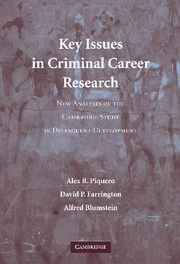 Key Issues in Criminal Career Research
Key Issues in Criminal Career Research Published online by Cambridge University Press: 30 July 2009
What does the longitudinal patterning of criminal activity over age look like? Such basic questions have been studied in the criminal career literature, sometimes resulting in different conclusions.
Prevalence provides a measure of how many individuals participate in a crime type in any period. The shape of the age-crime curve for prevalence is generally agreed upon by most criminologists as data typically provide similar conclusions regarding trends in shape (though self-report records sometimes show an earlier peak for some crime types and a later peak for others). Both official and self-report records suggest that the prevalence of offending increases to a peak in the teenage years, at about ages 15–19, and then declines in the 20s (Blumstein et al., 1986; Elliott et al., 1989; Farrington, 1986; Piquero et al., 2003; Wolfgang et al., 1987). Prevalence curves typically form the basis of many conclusions regarding the aggregate age/crime relationship.
On the other hand, estimates of individual offending frequency, though generally minimally studied, tend to vary considerably – often because the definition of individual offense frequency varies. Some researchers prefer to simply plot the number of offenses (frequency) engaged in by sample members over time or over a particular time period, while other researchers argue that individual offending frequency should be defined by the amount of crime engaged in over a particular time period among those offenders who are active (i.e., offending) during that time period.
The evidence on individual offending frequency is mixed.
To save this book to your Kindle, first ensure [email protected] is added to your Approved Personal Document E-mail List under your Personal Document Settings on the Manage Your Content and Devices page of your Amazon account. Then enter the ‘name’ part of your Kindle email address below. Find out more about saving to your Kindle.
Note you can select to save to either the @free.kindle.com or @kindle.com variations. ‘@free.kindle.com’ emails are free but can only be saved to your device when it is connected to wi-fi. ‘@kindle.com’ emails can be delivered even when you are not connected to wi-fi, but note that service fees apply.
Find out more about the Kindle Personal Document Service.
To save content items to your account, please confirm that you agree to abide by our usage policies. If this is the first time you use this feature, you will be asked to authorise Cambridge Core to connect with your account. Find out more about saving content to Dropbox.
To save content items to your account, please confirm that you agree to abide by our usage policies. If this is the first time you use this feature, you will be asked to authorise Cambridge Core to connect with your account. Find out more about saving content to Google Drive.